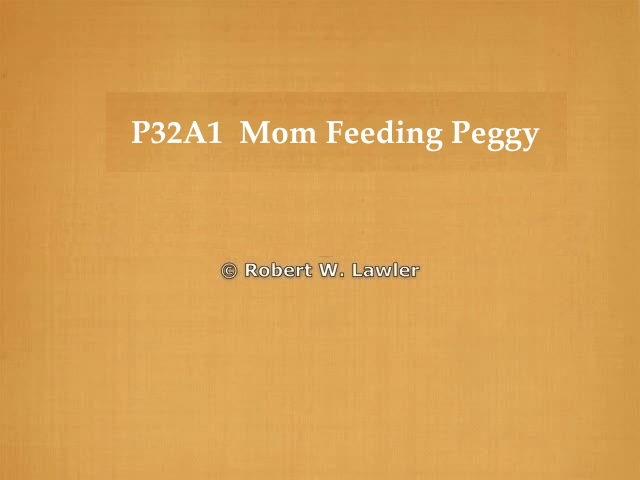
P32A1 Clip Notes
| Notes:n:nn | by Analyst, 9/26/2025 |
| Setting,Props | Cedar Hall, Family Room: |
| Actors,Aims | Mom Feeding Peggy; Bob on camera. document everyday activities |
| Episode A: [00:00:06] | Mom: Would you like some plums, Peggy? Plums? … More plums? That’s more… Lots… Here’ you go… You must be hungry… You’re gobbling it down… Peggy, would you like some more? |
| Episode B: [00:00:52] | Bob: Is she being distracted by Scurry? Mom: I believe so. Bob: Scurry, go to your place…. Go to your place, Scurry. Mom: More?… There you go. |
| Episode C: [00:01:30] | Bob: Well, it seems that the way you’re talking is quite different from the way I did, and that’s fine, because it’s really more important the way you’re doing. I think what I wrote down in the book is a sufficiently descriptive of what I did, so you can just forget about it. Mom: Peggy, would you like some more?… Bob: Ah! It’s Scurry’s ball now…. Distraction. Let me get rid of that, too. Mom: Peggy. Miriam: Go Blue Devils…. |
| Episode D: [00:02:13] | Peggy: [looks up at the cameraman] Bob: Well, I guess if I’m a distraction, I’ll have to leave again, right? Mom: I’m afraid the way her eyes are roaming around, just about anything is going to be a distraction. [holding up a jar] See this? When it’s a jar I’m going to do more of that…. Stop rattling around too. Bob: Yeah, I think she’s looking at the cameraman here. Hi, sweetie. Yeah, I’m talking to you, Peg. Hi. |
| Episode E: [00:02:43] | Mom: Here we go. More plums. Ready? Ready. Okay…. Hi, Peg. Bob: Why don’t I stop here? You continue feeding her, and then I’ll go get her cup and spoon while she wolfes her way through that plum. Mom: Jar of plums. |
| Episode | |
| Summary by AI |
Mom feeds Peggy plums; Peggy eats eagerly and is offered more repeatedly. Peggy gets distracted frequently, especially by the dog Scurry and the cameraman. Bob asks Scurry to go to his place and removes the dog’s ball to reduce distractions. Bob notes Mom’s interaction style differs from his, and says that’s fine and more important than his approach. He mentions his book’s description is sufficient and can be disregarded for the current situation. Mom comments that Peggy’s roaming eyes mean nearly anything can be distracting. Mom indicates that when there’s a jar, she’ll do “more of that” (likely more feeding cues/interaction). Miriam interjects cheerfully with “Go Blue Devils. Bob considers leaving if he’s a distraction and greets Peggy to get her attention. They decide Mom will continue feeding while Bob fetches Peggy’s cup and spoon as she finishes the jar of plums. |
| Narrative by AI |
A short home video captures a simple, familiar scene: a caregiver feeding a young child plums at the kitchen table while family life hums quietly in the background. The exchange is calm and repetitive—offers of “more plums,” small encouragements, brief pauses—punctuated by light conversation among adults and the occasional glance from the child toward the camera. It’s the kind of everyday moment that reveals the rhythms of caregiving without fanfare. Distraction quickly becomes a theme. A family dog named Scurry pads into view, then a ball rolls nearby, and the cameraman draws the child’s attention. The adults respond with gentle redirection—asking the dog to go to its place, removing the ball, and even considering leaving the room to reduce stimulation. They observe how the child’s eyes roam and adjust the environment accordingly, demonstrating the flexible, moment-to-moment problem-solving that feeding a curious, easily captivated child often requires. Amid the practicalities, there’s a thoughtful aside about communication. One adult notes that the style of talking to the child differs from how he once did it, and that what matters more is the doing—the steady, responsive care—rather than the exact words. He mentions having written down an approach in a book but suggests it’s only descriptive, not prescriptive. The comment frames the scene as a gentle reminder: in caregiving, techniques can vary, but presence and responsiveness are the constants that matter. The feeding continues with small rituals: showing the jar, announcing “more plums,” prompting readiness, then offering another spoonful. These predictable cues anchor the interaction, making it easier for the child to anticipate what comes next. Even as attention wanders, the caregiver keeps the pace unhurried and consistent, balancing patience with progress. When needed, another adult steps away to fetch a cup and spoon, illustrating the quiet teamwork that underpins many routine tasks. By the end, nothing extraordinary has occurred—and that’s precisely the point. The video offers a straightforward portrait of everyday care: managing distractions, coordinating roles, and focusing on the child’s comfort and engagement. In its ordinary details, the scene highlights how small, repeated choices—calm prompts, environmental tweaks, and shared attention—add up to a secure, nurturing experience. |
| Link Index | Panel P032, Language Development, Object Exploration, Social Interactions |
| Themes, Interplay |
